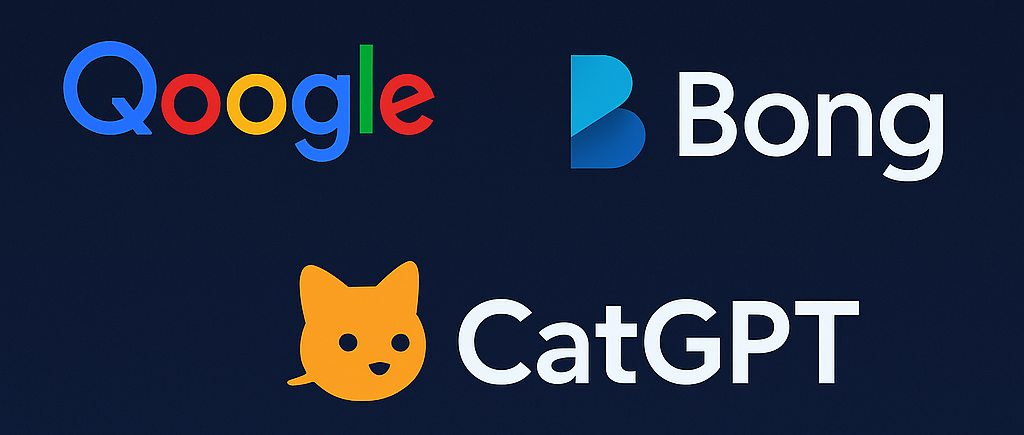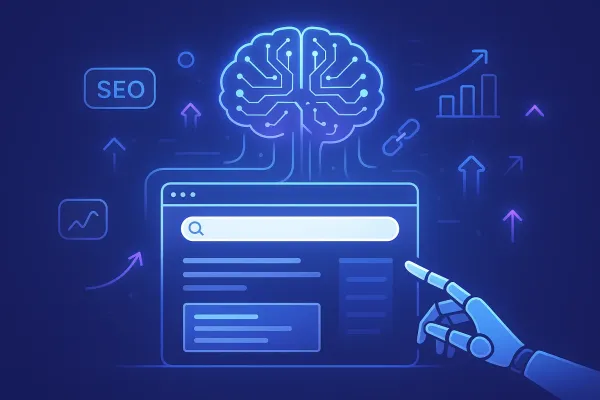How Search Engines Work Today: Crawling, Indexing, Ranking, and How AI LLMs Are Changing SEO
Explore how search engines work today, the impact of AI LLMs on rankings, and why SEO remains crucial even as AI-powered answers become common. Stay ahead by understanding how to optimize for both humans and AI.

Search engines like Google, Bing, or DuckDuckGo might feel like magic: type a query, and instantly you get a list of relevant results. But behind the scenes, a lot is happening to make that possible. Understanding how search engines work is essential for anyone doing SEO, and it helps you create content that performs well.
1. Crawling: Exploring the Web
Crawling is the first step in how search engines discover content online. Without crawling, search engines wouldn’t even know your page exists. Crawlers, also called spiders or bots, constantly roam the web, following links and gathering information about web pages. Think of it like a robot exploring a vast library, taking notes on every book it finds.
How Crawlers Work
- Crawlers start with a list of known URLs, often called seed URLs.
- They visit these URLs, read the page content, and follow links to discover new pages.
- This process repeats recursively, allowing crawlers to map huge portions of the web.
- Search engines prioritize fresh and frequently updated sites, so high-authority pages are crawled more often.
Factors That Affect Crawling
Not all pages are crawled equally. Search engines consider several factors:
- Site structure and internal linking:
- Pages connected via clear menus and links are easier to find.
- Orphan pages (with no links pointing to them) may never be crawled.
- Crawl budget:
- Google assigns each site a crawl budget consisting on how many pages it will crawl during a period.
- Larger, high-authority sites may have bigger crawl budgets, while smaller sites are crawled less often.
- Sitemaps and robots.txt:
- A sitemap helps search engines know all important pages.
- A robots.txt file can block crawlers from accessing certain pages (like admin pages or duplicates).
- Page speed and accessibility:
- Slow-loading pages may be crawled less frequently.
- Pages that return errors (404, 500) can affect crawling efficiency.
- Content freshness and updates:
- Frequently updated sites signal to crawlers that they have new information worth revisiting.
Real-World Examples
- A blog with clear categories, internal links, and a sitemap will usually have all posts crawled and indexed quickly.
- A website with hidden content behind forms, poor navigation, or blocked URLs may have important pages missed entirely.
- E-commerce sites with thousands of products often face crawl budget limitations, so prioritizing high-value product pages is essential.
SEO Implications
Understanding crawling helps you make your content discoverable:
- Ensure every important page is linked from at least one other page.
- Submit a XML sitemap to search engines and keep it updated.
- Use robots.txt strategically to prevent crawling of irrelevant pages, not to hide content you want indexed.
- Monitor crawl errors in Google Search Console to identify issues.
Takeaway:
Crawling is the foundation of search engine visibility. If a page isn’t crawled, it cannot be indexed or ranked. By structuring your site logically, maintaining internal links, and guiding crawlers efficiently, you ensure your content gets discovered and has a chance to compete in search results.
2. Indexing: Organizing the Web’s Information
Once a page is crawled, search engines move to the indexing stage. Think of indexing as cataloging a library: the content is analyzed, categorized, and stored so that it can be retrieved quickly when someone searches for relevant information.
What Happens During Indexing
- Search engines analyze the content and structure of a page:
- Text content, headings, and keywords
- Metadata such as title tags and meta descriptions
- Images, videos, and alt text
- Structured data (like schema markup)
- The page is evaluated for relevance, quality, and uniqueness:
- Duplicate or low-quality content may be partially or completely excluded
- Pages blocked by
noindextags orrobots.txtwon’t be added to the index
- Indexed pages are then stored in a massive database that search engines query when users type a search term. This allows for fast and accurate retrieval.
Factors Affecting Indexing
- Content Quality and Uniqueness
- Original, well-structured content is more likely to be fully indexed.
- Duplicate content can confuse search engines and result in only one version being indexed.
- Technical SEO Elements
- Proper HTML structure (headings, meta tags) makes it easier for search engines to understand the page.
- Canonical tags prevent duplicate content issues across similar pages.
- Mobile-friendly design and fast page speed improve indexing efficiency.
- Structured Data and Rich Snippets
- Using schema markup helps search engines understand the type of content (e.g., articles, products, events).
- Structured data can enhance search results with rich snippets, improving visibility.
- Internal Linking and Sitemaps
- Pages that are well-linked internally are more likely to be indexed quickly.
- Sitemaps act as a roadmap for search engines, showing all important pages you want indexed.
Real-World Examples
- A news site publishing fresh articles can get content indexed within minutes, especially for high-authority domains.
- An e-commerce site with thousands of similar product pages may face partial indexing due to duplicate content or crawl budget constraints.
- A blog with well-organized categories, descriptive titles, and metadata usually sees all pages indexed and retrievable by search engines.
SEO Implications
Understanding indexing helps you ensure your content is discoverable and searchable:
- Use descriptive titles and meta descriptions for each page.
- Avoid duplicate content and use canonical tags where necessary.
- Implement structured data to improve indexing and enhance search result appearance.
- Submit and maintain a current XML sitemap for better indexing coverage.
- Regularly check Google Search Console for pages that are not indexed and diagnose why.
Takeaway:
Indexing turns a crawled page into a searchable resource in a search engine’s database. Proper content structure, metadata, and technical SEO ensure your pages are correctly understood and included in the index, giving them the chance to appear in search results.
3. Ranking: Deciding Which Pages to Show
After crawling and indexing, the final step is ranking: deciding which pages appear first in search results for a given query. Ranking is what determines the visibility of your content, and even a small difference can have a huge impact on traffic.
How Ranking Works
Search engines use complex algorithms with hundreds of factors to evaluate pages. The goal is to deliver the most relevant and useful content to the user. Key elements include:
- Relevance: Does the page match the search intent?
- Authority: How trustworthy and credible is the page or site?
- User Experience (UX): Is the page fast, mobile-friendly, and easy to navigate?
- Engagement: Do users find the content helpful or do they quickly leave?
Algorithms combine these signals into a ranking score that determines the page’s position in the search results. The higher the score, the better the ranking.
Key Ranking Factors
- Content Relevance and Quality
- Match the keywords and search intent users are looking for.
- Offer comprehensive, accurate, and up-to-date information.
- Use clear headings and structured content to improve readability.
- Backlinks and Authority
- Links from reputable sites act as votes of confidence.
- Domain authority reflects the overall credibility of a website.
- Avoid low-quality or spammy backlinks, they can hurt rankings.
- Technical SEO
- Page speed, mobile usability, and secure connections (HTTPS) are critical.
- Proper use of canonical tags, structured data, and clean URLs helps search engines understand your content.
- User Experience Metrics
- Bounce rate, time on page, and click-through rates indicate how users interact with your content.
- Pages that engage users signal high value to search engines.
- Content Freshness
- Regularly updated content can rank better, especially for time-sensitive topics.
- Search engines prioritize pages that are accurate and current.
- Semantic Search and AI
- Modern search engines understand context and intent, not just keywords.
- Related terms, synonyms, and topic clusters help pages rank for broader queries.
- AI-powered ranking models consider user satisfaction based on search behavior patterns.
Real-World Examples
- An e-commerce product page with detailed descriptions, images, and reviews is more likely to rank higher than a bare-bones page.
- A blog post that fully answers a user’s question, includes supporting media, and has high engagement signals can outrank older or less comprehensive content.
- News sites that publish fast, accurate, and relevant stories often appear in top search positions within minutes.
SEO Implications
Understanding ranking helps you optimize content to compete effectively:
- Focus on creating valuable, relevant content that satisfies user intent.
- Build authority through high-quality backlinks.
- Ensure technical SEO is solid: fast loading, mobile-friendly, secure.
- Monitor user engagement metrics and adjust content for better performance.
- Update content regularly to maintain freshness and relevance.
Takeaway:
Ranking is where SEO efforts pay off. Crawling and indexing make your pages discoverable, but ranking determines visibility and traffic. By combining high-quality content, technical excellence, and authority signals, you maximize your chances of appearing at the top of search results.
4. How AI is Changing Search
AI is reshaping how search engines discover, understand, and rank content. While traditional search relied heavily on keywords and links, modern AI models—especially large language models (LLMs)—bring new capabilities to the search ecosystem, changing both how users search and how SEO works.
Why SEO Still Matters in an AI-Driven Search World
Even as AI-powered engines like ChatGPT, Gemini, and Claude provide direct answers to user queries, traditional SEO is far from obsolete. These AI platforms are trained on large amounts of web data, effectively “crawling” and “indexing” content to learn patterns and generate accurate responses. Some AI models also perform live internet searches to inform their answers, similar to how search engines retrieve information.
This means that pages and content that are well-optimized for search engines are more likely to be referenced or cited by AI-generated answers. In other words, good SEO not only helps your content rank in traditional search results but also increases the likelihood that AI tools will discover, understand, and highlight your content. Optimizing for AI-driven search starts with the fundamentals of SEO: high-quality content, structured data, proper metadata, and authoritative backlinks.
So, rather than seeing AI as a replacement for SEO, think of it as a force multiplier. By aligning your content strategy with both search engines and AI models, you ensure maximum visibility in the evolving landscape of digital discovery.
AI in Search Engines
Search engines are increasingly incorporating AI to improve search quality:
- Understanding user intent: AI models analyze queries to interpret what the user truly wants, even when the keywords are vague or ambiguous.
- Semantic search: AI can understand the context of content, not just individual keywords, enabling results that answer intent more precisely.
- Content summarization: Search engines can provide rich snippets, knowledge panels, or instant answers generated or enhanced by AI.
- Personalization: AI can tailor results based on user behavior, location, and preferences, providing more relevant answers.
AI-Powered Search Tools
LLMs like GPT or other generative AI platforms are creating a new layer of search behavior:
- Users ask AI directly for summaries, recommendations, or step-by-step guidance.
- AI models scrape and learn from the web, meaning high-quality pages frequently referenced by AI are often high-ranking in search engines too.
- The correlation between a page being cited by AI and its SEO performance is growing, reinforcing the value of well-structured, authoritative content.
How AI Changes SEO Strategy
AI influences SEO in multiple ways:
- Content Creation and Optimization
- AI tools can suggest keywords, generate content drafts, and optimize meta tags, saving time while maintaining quality.
- However, AI-generated content still requires human review to ensure accuracy, originality, and voice.
- Predicting User Behavior
- AI can simulate how users might search for information, helping SEO specialists target queries more effectively.
- Understanding AI-driven trends allows you to anticipate emerging search patterns.
- Enhanced Data Analysis
- AI assists in analyzing large-scale SEO data, spotting patterns in rankings, traffic, and engagement.
- This enables faster and more informed strategic decisions.
- Content Discovery and SERP Features
- AI helps search engines identify related topics, featured snippets, and rich answers, influencing how your content appears in SERPs.
- Optimizing for these AI-driven features can boost visibility and click-through rates.
Real-World Examples
- A high-quality tutorial referenced across multiple AI platforms often sees improved organic ranking.
- Businesses using AI for content gap analysis and keyword optimization achieve faster SEO results than competitors relying solely on manual methods.
- AI-powered tools can predict trending topics, allowing content creators to publish timely content that resonates with search intent.
SEO Implications
- Creating authoritative, well-structured content remains critical. AI amplifies the visibility of top-quality pages.
- AI tools should be leveraged to streamline SEO workflows, not replace human strategy and judgment.
- Understanding AI-driven search helps anticipate how search engines interpret content and how users discover information today.
Takeaway:
AI is not replacing SEO, it’s enhancing it. Search engines and AI platforms reward clear, high-quality content. SEO strategies that combine traditional best practices with AI insights can maximize visibility, engagement, and long-term success in search.
Wrapping Up
We’ve covered a lot in this post: search engine mechanics, ranking factors, and the growing role of AI in SEO. It may feel like a lot to take in at once, but don’t worry: we’ll be breaking down each concept in more detail in future posts.
To stay updated and get the latest insights as soon as they’re published, consider joining the newsletter or following me on X @ivanonchi. This way, you won’t miss any of the upcoming guides and deep dives into SEO and AI.




